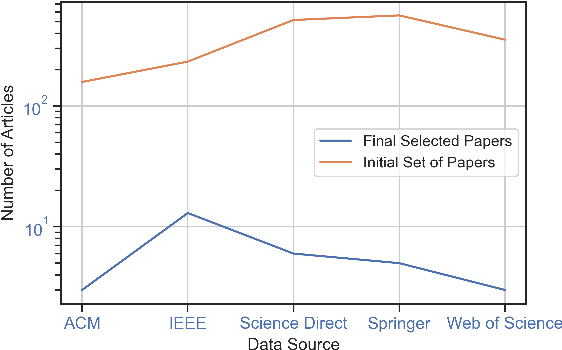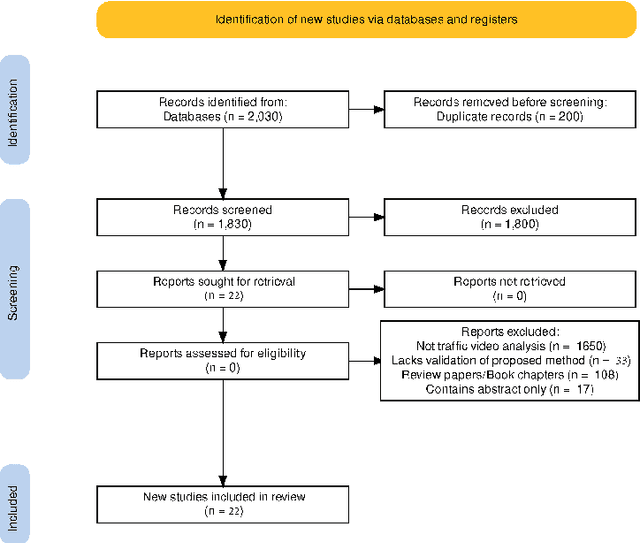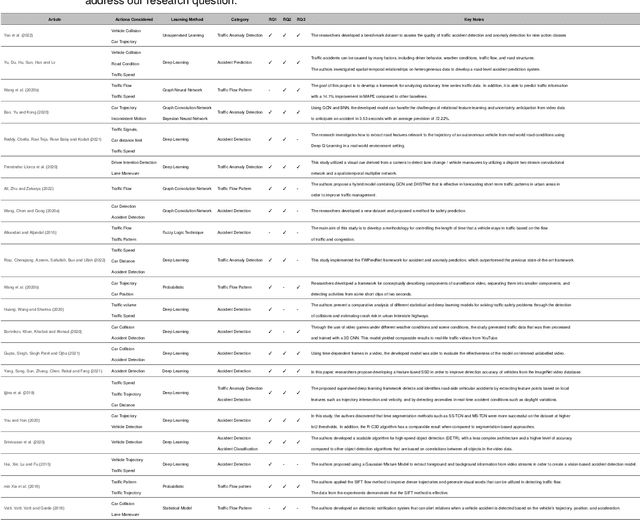Victor Adewopo
Big Data and Deep Learning in Smart Cities: A Comprehensive Dataset for AI-Driven Traffic Accident Detection and Computer Vision Systems
Jan 07, 2024Abstract:In the dynamic urban landscape, where the interplay of vehicles and pedestrians defines the rhythm of life, integrating advanced technology for safety and efficiency is increasingly crucial. This study delves into the application of cutting-edge technological methods in smart cities, focusing on enhancing public safety through improved traffic accident detection. Action recognition plays a pivotal role in interpreting visual data and tracking object motion such as human pose estimation in video sequences. The challenges of action recognition include variability in rapid actions, limited dataset, and environmental factors such as (Weather, Illumination, and Occlusions). In this paper, we present a novel comprehensive dataset for traffic accident detection. This datasets is specifically designed to bolster computer vision and action recognition systems in predicting and detecting road traffic accidents. We integrated datasets from wide variety of data sources, road networks, weather conditions, and regions across the globe. This approach is underpinned by empirical studies, aiming to contribute to the discourse on how technology can enhance the quality of life in densely populated areas. This research aims to bridge existing research gaps by introducing benchmark datasets that leverage state-of-the-art algorithms tailored for traffic accident detection in smart cities. These dataset is expected to advance academic research and also enhance real-time accident detection applications, contributing significantly to the evolution of smart urban environments. Our study marks a pivotal step towards safer, more efficient smart cities, harnessing the power of AI and machine learning to transform urban living.
Smart City Transportation: Deep Learning Ensemble Approach for Traffic Accident Detection
Oct 16, 2023Abstract:The dynamic and unpredictable nature of road traffic necessitates effective accident detection methods for enhancing safety and streamlining traffic management in smart cities. This paper offers a comprehensive exploration study of prevailing accident detection techniques, shedding light on the nuances of other state-of-the-art methodologies while providing a detailed overview of distinct traffic accident types like rear-end collisions, T-bone collisions, and frontal impact accidents. Our novel approach introduces the I3D-CONVLSTM2D model architecture, a lightweight solution tailored explicitly for accident detection in smart city traffic surveillance systems by integrating RGB frames with optical flow information. Our experimental study's empirical analysis underscores our approach's efficacy, with the I3D-CONVLSTM2D RGB + Optical-Flow (Trainable) model outperforming its counterparts, achieving an impressive 87\% Mean Average Precision (MAP). Our findings further elaborate on the challenges posed by data imbalances, particularly when working with a limited number of datasets, road structures, and traffic scenarios. Ultimately, our research illuminates the path towards a sophisticated vision-based accident detection system primed for real-time integration into edge IoT devices within smart urban infrastructures.
AI on the Road: A Comprehensive Analysis of Traffic Accidents and Accident Detection System in Smart Cities
Jul 22, 2023Abstract:Accident detection and traffic analysis is a critical component of smart city and autonomous transportation systems that can reduce accident frequency, severity and improve overall traffic management. This paper presents a comprehensive analysis of traffic accidents in different regions across the United States using data from the National Highway Traffic Safety Administration (NHTSA) Crash Report Sampling System (CRSS). To address the challenges of accident detection and traffic analysis, this paper proposes a framework that uses traffic surveillance cameras and action recognition systems to detect and respond to traffic accidents spontaneously. Integrating the proposed framework with emergency services will harness the power of traffic cameras and machine learning algorithms to create an efficient solution for responding to traffic accidents and reducing human errors. Advanced intelligence technologies, such as the proposed accident detection systems in smart cities, will improve traffic management and traffic accident severity. Overall, this study provides valuable insights into traffic accidents in the US and presents a practical solution to enhance the safety and efficiency of transportation systems.
Baby Physical Safety Monitoring in Smart Home Using Action Recognition System
Oct 22, 2022Abstract:Humans are able to intuitively deduce actions that took place between two states in observations via deductive reasoning. This is because the brain operates on a bidirectional communication model, which has radically improved the accuracy of recognition and prediction based on features connected to previous experiences. During the past decade, deep learning models for action recognition have significantly improved. However, deep neural networks struggle with these tasks on a smaller dataset for specific Action Recognition (AR) tasks. As with most action recognition tasks, the ambiguity of accurately describing activities in spatial-temporal data is a drawback that can be overcome by curating suitable datasets, including careful annotations and preprocessing of video data for analyzing various recognition tasks. In this study, we present a novel lightweight framework combining transfer learning techniques with a Conv2D LSTM layer to extract features from the pre-trained I3D model on the Kinetics dataset for a new AR task (Smart Baby Care) that requires a smaller dataset and less computational resources. Furthermore, we developed a benchmark dataset and an automated model that uses LSTM convolution with I3D (ConvLSTM-I3D) for recognizing and predicting baby activities in a smart baby room. Finally, we implemented video augmentation to improve model performance on the smart baby care task. Compared to other benchmark models, our experimental framework achieved better performance with less computational resources.
Review on Action Recognition for Accident Detection in Smart City Transportation Systems
Aug 20, 2022



Abstract:Action detection and public traffic safety are crucial aspects of a safe community and a better society. Monitoring traffic flows in a smart city using different surveillance cameras can play a significant role in recognizing accidents and alerting first responders. The utilization of action recognition (AR) in computer vision tasks has contributed towards high-precision applications in video surveillance, medical imaging, and digital signal processing. This paper presents an intensive review focusing on action recognition in accident detection and autonomous transportation systems for a smart city. In this paper, we focused on AR systems that used diverse sources of traffic video capturing, such as static surveillance cameras on traffic intersections, highway monitoring cameras, drone cameras, and dash-cams. Through this review, we identified the primary techniques, taxonomies, and algorithms used in AR for autonomous transportation and accident detection. We also examined data sets utilized in the AR tasks, identifying the main sources of datasets and features of the datasets. This paper provides potential research direction to develop and integrate accident detection systems for autonomous cars and public traffic safety systems by alerting emergency personnel and law enforcement in the event of road accidents to minimize human error in accident reporting and provide a spontaneous response to victims
Deep Learning Algorithm for Threat Detection in Hackers Forum (Deep Web)
Feb 03, 2022Abstract:In our current society, the inter-connectivity of devices provides easy access for netizens to utilize cyberspace technology for illegal activities. The deep web platform is a consummative ecosystem shielded by boundaries of trust, information sharing, trade-off, and review systems. Domain knowledge is shared among experts in hacker's forums which contain indicators of compromise that can be explored for cyberthreat intelligence. Developing tools that can be deployed for threat detection is integral in securing digital communication in cyberspace. In this paper, we addressed the use of TOR relay nodes for anonymizing communications in deep web forums. We propose a novel approach for detecting cyberthreats using a deep learning algorithm Long Short-Term Memory (LSTM). The developed model outperformed the experimental results of other researchers in this problem domain with an accuracy of 94\% and precision of 90\%. Our model can be easily deployed by organizations in securing digital communications and detection of vulnerability exposure before cyberattack.
 Add to Chrome
Add to Chrome Add to Firefox
Add to Firefox Add to Edge
Add to Edge